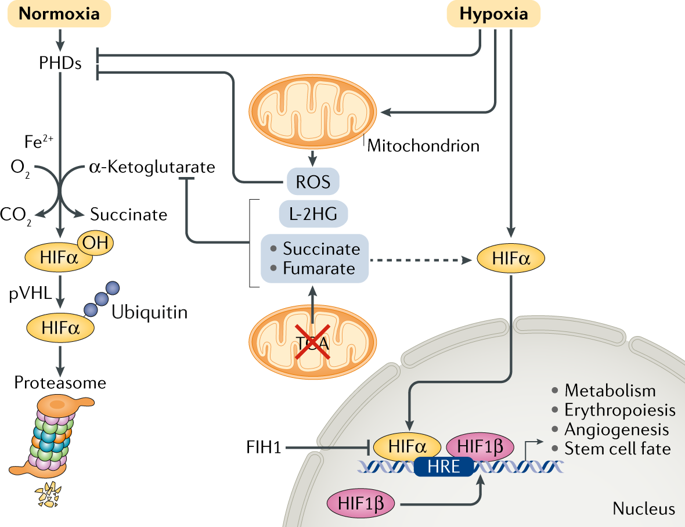当前位置:
X-MOL 学术
›
Nat. Rev. Mol. Cell Biol.
›
论文详情
Our official English website, www.x-mol.net, welcomes your
feedback! (Note: you will need to create a separate account there.)
Cellular adaptation to hypoxia through hypoxia inducible factors and beyond.
Nature Reviews Molecular Cell Biology ( IF 81.3 ) Pub Date : 2020-03-06 , DOI: 10.1038/s41580-020-0227-y Pearl Lee 1 , Navdeep S Chandel 2, 3 , M Celeste Simon 1, 4
Nature Reviews Molecular Cell Biology ( IF 81.3 ) Pub Date : 2020-03-06 , DOI: 10.1038/s41580-020-0227-y Pearl Lee 1 , Navdeep S Chandel 2, 3 , M Celeste Simon 1, 4
Affiliation

|
Molecular oxygen (O2) sustains intracellular bioenergetics and is consumed by numerous biochemical reactions, making it essential for most species on Earth. Accordingly, decreased oxygen concentration (hypoxia) is a major stressor that generally subverts life of aerobic species and is a prominent feature of pathological states encountered in bacterial infection, inflammation, wounds, cardiovascular defects and cancer. Therefore, key adaptive mechanisms to cope with hypoxia have evolved in mammals. Systemically, these adaptations include increased ventilation, cardiac output, blood vessel growth and circulating red blood cell numbers. On a cellular level, ATP-consuming reactions are suppressed, and metabolism is altered until oxygen homeostasis is restored. A critical question is how mammalian cells sense oxygen levels to coordinate diverse biological outputs during hypoxia. The best-studied mechanism of response to hypoxia involves hypoxia inducible factors (HIFs), which are stabilized by low oxygen availability and control the expression of a multitude of genes, including those involved in cell survival, angiogenesis, glycolysis and invasion/metastasis. Importantly, changes in oxygen can also be sensed via other stress pathways as well as changes in metabolite levels and the generation of reactive oxygen species by mitochondria. Collectively, this leads to cellular adaptations of protein synthesis, energy metabolism, mitochondrial respiration, lipid and carbon metabolism as well as nutrient acquisition. These mechanisms are integral inputs into fine-tuning the responses to hypoxic stress.
中文翻译:

细胞通过缺氧诱导因子等对缺氧进行适应。
分子氧 (O2) 维持细胞内生物能并被众多生化反应消耗,这使其对地球上的大多数物种至关重要。因此,氧浓度降低(缺氧)是一种主要的应激源,通常会破坏需氧物种的生命,并且是细菌感染、炎症、伤口、心血管缺陷和癌症中遇到的病理状态的显着特征。因此,哺乳动物已经进化出了应对缺氧的关键适应机制。从系统角度来说,这些适应包括增加通气量、心输出量、血管生长和循环红细胞数量。在细胞水平上,ATP 消耗反应受到抑制,新陈代谢发生改变,直到氧稳态恢复。一个关键问题是哺乳动物细胞如何感知氧气水平以协调缺氧期间的不同生物输出。研究最充分的缺氧反应机制涉及缺氧诱导因子 (HIF),它们通过低氧利用率而稳定,并控制多种基因的表达,包括那些涉及细胞存活、血管生成、糖酵解和侵袭/转移的基因。重要的是,氧气的变化也可以通过其他应激途径以及代谢物水平的变化和线粒体产生的活性氧来感知。总的来说,这导致细胞对蛋白质合成、能量代谢、线粒体呼吸、脂质和碳代谢以及营养获取的适应。这些机制是微调对缺氧应激反应的不可或缺的输入。
更新日期:2020-03-06
中文翻译:

细胞通过缺氧诱导因子等对缺氧进行适应。
分子氧 (O2) 维持细胞内生物能并被众多生化反应消耗,这使其对地球上的大多数物种至关重要。因此,氧浓度降低(缺氧)是一种主要的应激源,通常会破坏需氧物种的生命,并且是细菌感染、炎症、伤口、心血管缺陷和癌症中遇到的病理状态的显着特征。因此,哺乳动物已经进化出了应对缺氧的关键适应机制。从系统角度来说,这些适应包括增加通气量、心输出量、血管生长和循环红细胞数量。在细胞水平上,ATP 消耗反应受到抑制,新陈代谢发生改变,直到氧稳态恢复。一个关键问题是哺乳动物细胞如何感知氧气水平以协调缺氧期间的不同生物输出。研究最充分的缺氧反应机制涉及缺氧诱导因子 (HIF),它们通过低氧利用率而稳定,并控制多种基因的表达,包括那些涉及细胞存活、血管生成、糖酵解和侵袭/转移的基因。重要的是,氧气的变化也可以通过其他应激途径以及代谢物水平的变化和线粒体产生的活性氧来感知。总的来说,这导致细胞对蛋白质合成、能量代谢、线粒体呼吸、脂质和碳代谢以及营养获取的适应。这些机制是微调对缺氧应激反应的不可或缺的输入。































 京公网安备 11010802027423号
京公网安备 11010802027423号